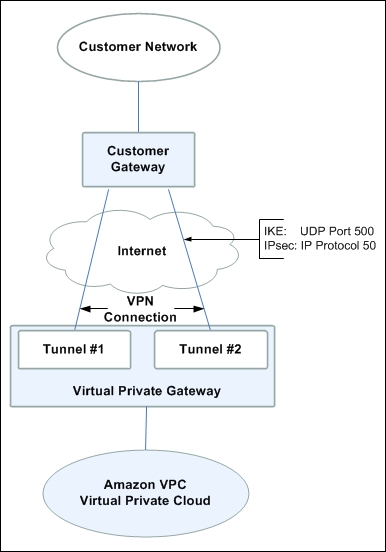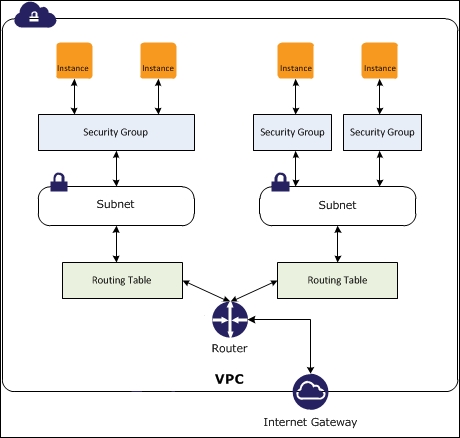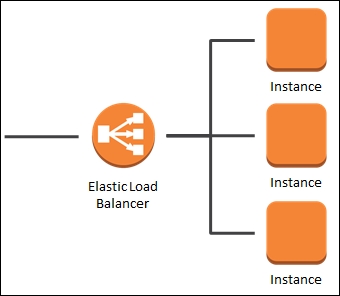Having discussed both AWS and OpenStack, first, we will explore the AWS approach to networking, before looking at an alternative method using OpenStack and compare the two approaches. When first setting up networking in AWS, a tenant network in AWS is instantiated using VPC, which post 2013 deprecated AWS classic mode; but what is VPC?
A VPC is the new default setting for new customers wishing to access AWS. VPCs can also be connected to customer networks (private data centers) by allowing AWS cloud to extend a private data center for agility. The concept of connecting a private data center to an AWS VPC is using something AWS refers to as a customer gateway and virtual private gateway. A virtual private gateway in simple terms is just two redundant VPN tunnels, which are instantiated from the customer's private network.
Customer gateways expose a set of external static addresses from a customer site, which are typically Network Address Translation-Traversal (NAT-T) to hide the source address. UDP port 4500 should be accessible in the external firewall in the private data center. Multiple VPCs can be supported from one customer gateway device.

A VPC gives an isolated view of everything an AWS customer has provisioned in AWS public cloud. Different user accounts can then be set up against VPC using the AWS Identity and Access Management (IAM) service, which has customizable permissions.
The following example of a VPC shows instances (virtual machines) mapped with one or more security groups and connected to different subnets connected to the VPC router:

A VPC simplifies networking greatly by putting the constructs into software and allows users to perform the following network functions:
By default, when an instance (virtual machine) is instantiated in a VPC, it will either be placed on a default subnet or custom subnet if specified.
All VPCs come with a default router when the VPC is created, the router can have additional custom routes added and routing priority can also be set to forward traffic to particular subnets.
When an instance is spun up in AWS, it will automatically be assigned a mandatory private IP address by Dynamic Host Configuration Protocol (DHCP) as well as a public IP and DNS entry too unless dictated otherwise. Private IPs are used in AWS to route east-west traffic between instances when virtual machine needs to communicate with adjacent virtual machines on the same subnet, whereas public IPs are available through the Internet.
If a persistent public IP address is required for an instance, AWS offers the elastic IP addresses feature, which is limited to five per VPC account, which any failed instances IP address can be quickly mapped to another instance. It is important to note that it can take up to 24 hours for a public IP address's DNS Time To Live (TTL) to propagate when using AWS.
In terms of throughput, AWS instances can support a Maximum Transmission Unit (MTU) of 1,500 that can be passed to an instance in AWS, so this needs to be considered when considering application performance.
Security groups in AWS are a way of grouping permissive ACL rules, so don't allow explicit denies. AWS security groups act as a virtual firewall for instances, and they can be associated with one or more instances' network interfaces. In a VPC, you can associate a network interface with up to five security groups, adding up to 50 rules to a security group, with a maximum of 500 security groups per VPC. A VPC in an AWS account automatically has a default security group, which will be automatically applied if no other security groups are specified.
Default security groups allow all outbound traffic and all inbound traffic only from other instances in a VPC that also use the default security group. The default security group cannot be deleted. Custom security groups when first created allow no inbound traffic, but all outbound traffic is allowed.
Permissive ACL rules associated with security groups govern inbound traffic and are added using the AWS console (GUI) as shown later in the text, or they can be programmatically added using APIs. Inbound ACL rules associated with security groups can be added by specifying type, protocol, port range, and the source address. Refer to the following screenshot:

A VPC has access to different regions and availability zones of shared compute, which dictate the data center that the AWS instances (virtual machines) will be deployed in. Regions in AWS are geographic areas that are completely isolated by design, where availability zones are isolated locations in that specific region, so an availability zone is a subset of a region.
AWS gives users the ability to place their resources in different locations for redundancy as sometimes the health of a specific region or availability zone can suffer issues. Therefore, AWS users are encouraged to use more than one availability zones when deploying production workloads on AWS. Users can choose to replicate their instances and data across regions if they choose to.
Within each isolated AWS region, there are child availability zones. Each availability zone is connected to sibling availability zones using low latency links. All communication from one region to another is across the public Internet, so using geographically distant regions will acquire latency and delay. Encryption of data should also be considered when hosting applications that send data across regions.
AWS also allows Elastic Load Balancing (ELB) to be configured within a VPC as a bolt-on service. ELB can either be internal or external. When ELB is external, it allows the creation of an Internet-facing entry point into your VPC using an associated DNS entry and balances load between different instances. Security groups are assigned to ELBs to control the access ports that need to be used.
The following image shows an elastic load balancer, load balancing 3 instances:




